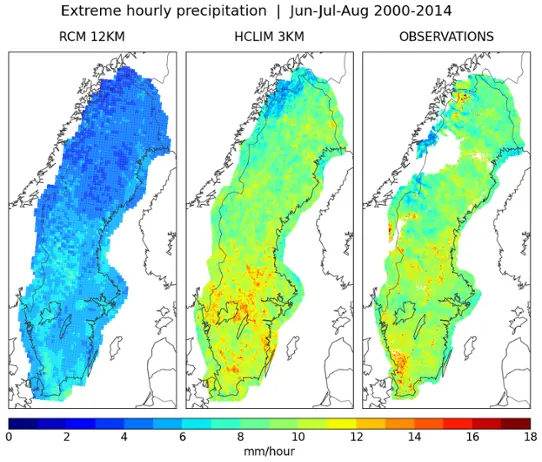New generation of high resolution climate models used at the Rossby Centre
As the climate changes, high-resolution and regional climate models become increasingly important as a basis for decision making. HCLIM is a regional climate model that can run at high resolution and is able to reproduce precipitation extremes, urban temperature, climate over mountainous regions and wind over complex coastlines much more realistically compared to the models used until now.
Sweden has experienced a range of extreme events that are likely to be stronger and more frequent in the future climate; these include cloudbursts and flooding (e.g. Malmö flooding in 2014), heat waves (e.g. the summer of 2018) with considerable impacts on urban areas and forest fires, and wind extremes (e.g. storm Gudrun in 2005). Such types of events are not well reproduced in the currently available climate simulations with horizontal resolutions not finer than 12 km, and require the use of new generation of climate models with horizontal resolutions of 1 to 4 km.
HARMONIE-Climate (HCLIM; Belušić et al., 2020) can much more realistically reproduce convection and extreme precipitation. As an example, Figure 1 presents the time of maximum precipitation intensity during the diurnal cycle around Lake Victoria (Africa’s greatest lake) from observations and from different model simulations. In contrast to a typical current regional climate model (RCM), the time of maximum precipitation intensity during the diurnal cycle over land is very well simulated by HCLIM-AROME at 2.5 km. This is in accordance with additional results for different European regions and with previous results using other high resolution models.
 Zoom image
Zoom imageFigure 1: Time of maximum precipitation intensity during the diurnal cycle around Lake Victoria for (a) observations with 12.5 km resolution, (b) RCM with 25 km resolution, (c) RCM with 12 km resolution and (d) HCLIM-AROME with 2.5 km resolution.
Considerable advantages and new insights
The new generation of high resolution climate models offer considerable advantages and new insights compared to the typical global and regional climate models; for example, they have much better representation of extreme precipitation and often show a larger increase in extreme precipitation in the future. Furthermore, due to the high resolution, they improve local climate projections, such as for urban heat waves, mountain climates and winds over complex coastlines. Consequently, there is a large interest from users for such climate information.
HCLIM is developed and maintained by a group of national meteorological institutes and is now being applied in several ongoing international collaborative projects over a number of regions in Europe. The first climate projections over Fenno-Scandinavia with 3 km horizontal resolution have been performed within the collaborative project Nordic Convection Permitting Climate Projections (NorCP). In Sweden (Figure 2) the model will be used to systematically investigate the climate change information on local scales, which is relevant to a wide range of stakeholders from interdisciplinary researchers to municipalities.
HCLIM is based on the model for everyday weather forecasting at SMHI and other collaborating institutes making it especially useful for addressing observed weather and extreme events in a climate change perspective. Activities are under way to further explore and promote the benefits of using the same model system for short-term weather forecasting and long-term climate applications.

Figure 2: Intensity of extreme hourly summer precipitation in a currently available RCM (left), HCLIM-AROME (centre) and HIPRAD observations (right).


